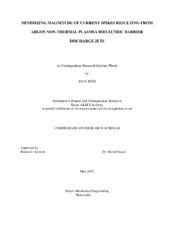| dc.creator | Reid, Jack Burnett | |
| dc.date.accessioned | 2017-10-10T20:27:13Z | |
| dc.date.available | 2017-10-10T20:27:13Z | |
| dc.date.created | 2015-05 | |
| dc.date.issued | 2014-10-06 | |
| dc.date.submitted | May 2015 | |
| dc.identifier.uri | https://hdl.handle.net/1969.1/164477 | |
| dc.description.abstract | The electrical current profiles of two mediums, helium and argon, in a sinusoidally driven floating electrode dielectric barrier discharge jet acting on a substrate were examined for differences. It was noted that the argon plasma resulted in current spikes and more tactile electrical pain than the helium plasma. System inductance was varied by the addition of a 4.5mH coiled wire inductor between the electrode and the high voltage power source in an effort to minimize these current spikes. This effort was successful and resulted in a 6.9mA (71%) reduction in argon current spike magnitude. Since tactile pain due to electrical stimulation is a known effect of current magnitude, minimizing the spikes should reduce the pain caused by argon plasma. Such a reduction would make argon much more feasible as a plasma medium for medical applications in particular, but industrial applications as well. | en |
| dc.format.mimetype | application/pdf | |
| dc.subject | plasma, medicine, non-thermal, dielectric barrier discharge, helium, argon, tactile, sensation | en |
| dc.title | Minimizing Magnitude of Current Spikes Resulting from Argon Non-Thermal Dielectric Barrier Discharge Jets | en |
| dc.type | Thesis | en |
| thesis.degree.department | Mechanical Engineering | en |
| thesis.degree.discipline | Mechanical Engineering | en |
| thesis.degree.grantor | Undergraduate Research Scholars Program | en |
| dc.contributor.committeeMember | Staack, David | |
| dc.type.material | text | en |
| dc.date.updated | 2017-10-10T20:27:13Z | |


